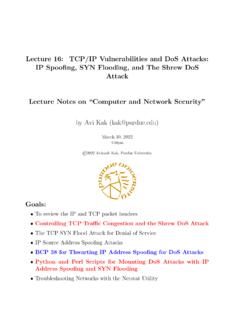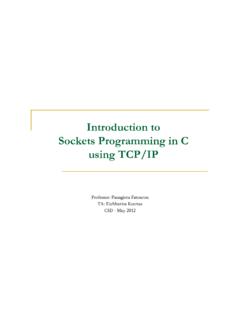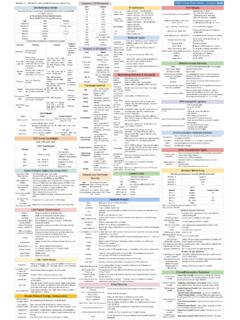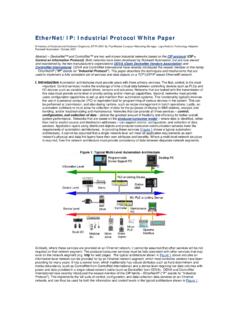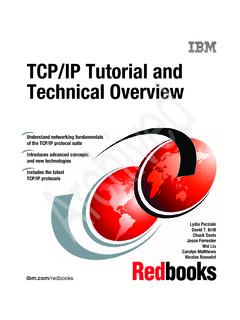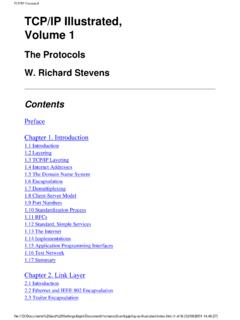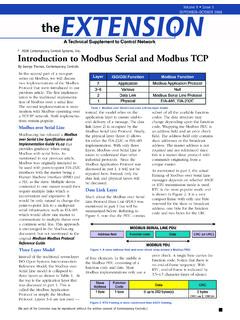Transcription of THE TCP/IP PROTOCOL SUITE
1 A truck or plane. It sounds like a very complicated way to deliver one message, but this system makes the overall task of delivering many messages easier, not harder. For example, there now can be facilities that only deal with mailbags and do not worry about an individual letter s language or the transportation TCP/IP PROTOCOL SUITEThe PROTOCOL stack used on the internet is the internet PROTOCOL SUITE . It is usually called TCP/IP after two of its most prominent protocols, but there are other proto-cols as well. The TCP/IP model is based on a fi ve-layer model for networking. From bottom (the link) to top (the user application), these are the physical, data link, net-work, transport, and application layers. Not all layers are completely defi ned by the model, so these layers are fi lled in by external standards and protocols.
2 The layers have names but no numbers, and although sometimes people speak of Layer 2 or Layer 3, these are not TCP/IP terms. Terms like these are actually from the OSI Refer-ence TCP/IP stack is open, which means that there are no secrets as to how it works. (There are open systems too, but with TCP/IP , the systems do not have to be open and often are not.) Two compatible end-system applications can communicate regardless of their underlying architectures, although the connections between layers are not defi OSI Reference ModelThe TCP/IP or internet model is not the only standard way to build a PROTOCOL SUITE or stack. The Open Standard Interconnection (OSI ) reference model is a seven-layer model that loosely maps into the fi ve layers of TCP/IP .
3 Until the Web became widely popular in the 1990s, the OSI reference model, with distinctive names and numbers for its layers, was proposed as the standard model for all communication networks. Today, the OSI reference model (OSI-RM) is often used as a learning tool to introduce the functions of TCP/IP stack is comprised of modules. Each module provides a specifi c function, but the modules are fairly independent. The TCP/IP layers contain relatively independent protocols that can be used depending on the needs of the system to provide whatever function is desired. In TCP/IP , each higher layer PROTOCOL is sup-ported by lower layer protocols. The whole collection of protocols forms a type of hourglass shape, with IP in the middle, and more and more protocols up or down from 1 Protocols and Layers25 The TCP/IP LayersThe TCP/IP PROTOCOL stack models a series of PROTOCOL layers for networks and systems that allows communications between any types of devices.
4 The model consists of fi ve separate but related layers, as shown in Figure The internet PROTOCOL SUITE is based on these fi ve layers. TCP/IP says most about the network and transport layers, and a lot about the application layer. TCP/IP also defi nes how to interface the network layer with the data link and physical layers, but is not directly concerned with these two layers internet PROTOCOL SUITE assumes that a layer is there and available, so TCP/IP does not defi ne the layers themselves. The stack consist of protocols, not implementa-tions, so describing a layer or protocols says almost nothing about how these things should actually be all systems on a network need to implement all fi ve layers of TCP/IP .
5 Devices using the TCP/IP PROTOCOL stack fall into two general categories: a host or end system (ES) and an intermediate node (often a router) or an intermediate system (IS). The User Application ProgramsApplication LayerTransport LayerNetwork LayerData Link LayerPhysical LayerNetwork Link(s)FIGURE fi ve layers of TCP/IP . Older models often show only four layers, combining the physical and data link , Stack, and ModelThe term PROTOCOL stack is often used synonymously with PROTOCOL SUITE as an implementation of a reference model. However, the term PROTOCOL SUITE properly refers to a collection of all the protocols that can make up a layer in the reference model. The internet PROTOCOL SUITE is an example of the internet or TCP/IP refer-ence model protocols, and a TCP/IP PROTOCOL stack implements one or more of these protocols at each I Networking Basicsintermediate nodes usually only involve the fi rst three layers of TCP/IP (although many of them still have all fi ve layers for other reasons, as we have seen).
6 In TCP/IP , as with most layered protocols, the most fundamental elements of the process of sending and receiving data are collected into the groups that become the layers. Each layer s major functions are distinct from all the others, but layers can be combined for performance reasons. Each implemented layer has an interface with the layers above and below it (except for the application and physical layers, of course) and provides its defi ned service to the layer above and obtains services from the layer below. In other words, there is a service interface between each layer, but these are not standardized and vary widely by operating is designed to be comprehensive and fl exible. It can be extended to meet new requirements, and has been. Individual layers can be combined for implementation purposes, as long as the service interfaces to the layers remain intact.
7 Layers can even be split when necessary, and new service interfaces defi ned. Services are provided to the layer above after the higher layer provides the lower layer with the command, data, and necessary parameters for the lower layer to carry out the on the same system provide and obtain services to and from adjacent layers. However, a peer-to-peer PROTOCOL process allows the same layers on different systems to communicate. The term peer means every implementation of some layer is essentially equal to all others. There is no master system at the PROTOCOL level. Communications between peer layers on different systems use the defi ned protocols appropriate to the given other words, services refer to communications between layers within the same process, and protocols refer to communications between processes.
8 This can be con-fusing, so more information about these points is a good and InterfacesIt is important to note that when the layers of TCP/IP are on different systems, they are only connected at the physical layer. Direct peer-to-peer communication between all other layers is impossible. This means that all data from an application have to fl ow down through all fi ve layers at the sender, and up all fi ve layers at the receiver to reach the correct process on the other system. These data are sometimes called a ser-vice data unit (SDU).Each layer on the sending system adds information to the data it receives from the layer above and passes it all to the layer below (except for the physical layer, which has no lower layers to rely on in the model and actually has to send the bits in a form appropriate for the communications link used).
9 Likewise, each layer on the receiving system unwraps the received message, often called a PROTOCOL data unit (PDU), with each layer examining, using, and stripping off the information it needs to complete its task, and passing the remainder up to the next layer (except for the application layer, which passes what s left off to the application program itself). For example, the data link layer removes the wrapper meant for it, uses it to decide what it should do with this data unit, and then passes the remainder up to the network 1 Protocols and Layers27 The whole interface and PROTOCOL process is shown in Figure Although TCP/IP layers only have names, layer numbers are also used in the fi gure, but only for illustra-tion. (The numbers come from the ISO-RM.)As shown in the fi gure, there is a natural grouping of the fi ve-layer PROTOCOL stack at the network layer and the transport layer.
10 The lower three layers of TCP/IP , some-times called the network support layers, must be present and functional on all systems, regardless of the end system or intermediate node role. The transport layer links the upper and lower layers together. This layer can be used to make sure that what was sent was received, and what was sent is useful to the receiver (and not, for example, a stray PDU misdirected to the host or unreasonably delayed).The process of encapsulation makes the whole architecture workable. Encapsu-lation of one layer s information inside another layer is a key part of how TCP/IP layer uses encapsulation to add the information its peer needs on the receiving system. The network layer adds a header to the information it receives from the trans-port at the sender and passes the whole unit down to the data link layer.


